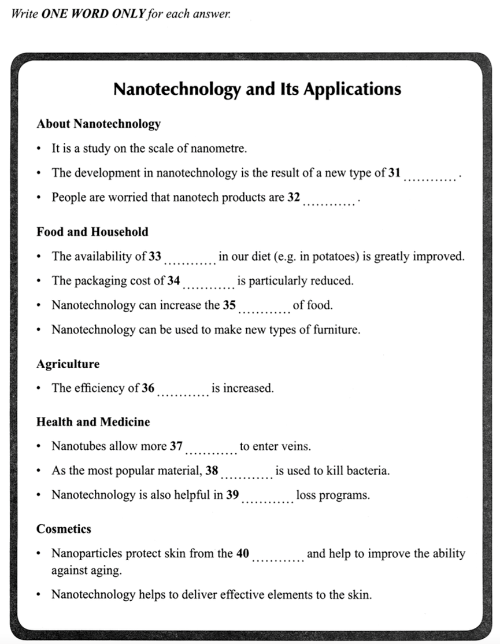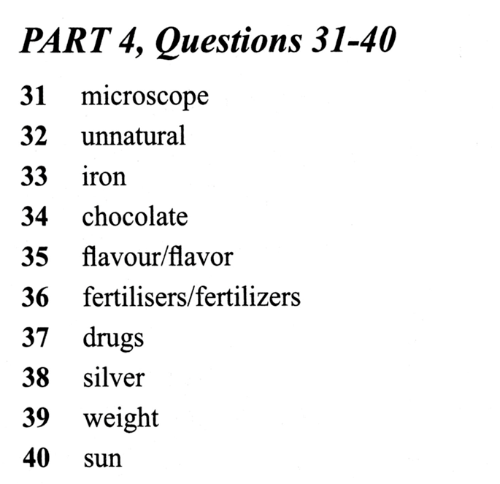当前位置:首页 > 雅思频道 > 雅思机经 > 直击考场 | 12月21日雅思考试回忆
发布时间:2024-12-23 关键词:雅思考试回忆
摘要:总览:本场听力考试难度虽然不低,但是出现了不少旧题。题型整体常规,整体语速正常;本场考试Part1场景为常考家居类场景
听力分析
总览:本场听力考试难度虽然不低,但是出现了不少旧题。题型整体常规,整体语速正常;本场考试Part1场景为常考家居类场景,所以考生备考时一定要积累常考场景的词汇;Part2出现了匹配题,难度比较正常,一定要关注和积累同意替换;Part 3出现双选题,看题和听音的压力相对较大,所以考试时一定要合理分配时间,提前勾画读题,一定要熟练掌握各种题型的做题方法并针对薄弱环节加强训练;Part 4再次出现了《新航道9分达人听力6》原题,这一系列书的含金量不言而喻,大家平常一定要多多练习精听并刷爆9分达人。
【以下答案和顺序仅供参考】
Part 1 购买家具
题型:填空题
1. width of bed: 140cm
2. price: 265
3. color: natural
4. fitted light which is convenience for reading
5. door of cupboard: glass
6. shelves: locked drawer
7. name: Rogaia
8. postcode: HE254EU
9. recommended deliver time: morning
10. If she is not in, please leave the goods delivered in the garage
(答案仅供参考,实际答案及顺序可能有变化)
P1 点评:
Part 1为旧题,常考场景之购买物品,家具类也是高频词范围,与租房话题有很大的相关性,备考时一定要认真准备常考的场景,积累高频出现的词汇;Part 1基础考点的占比非常大,答案词整体偏简单,但是注意音频中的转折和陷阱。没有涉及到单复数,可根据题干提示做预判,但也要仔细辨别尾音。
Part 2 海边野生动物中心的介绍
题型:5单选题+5匹配题
参考答案:
11—B mangrove swamp
12—A plants
13—can see animals roam freely
14—A develop website significantly
15—C name different animals and plants
16-20搭配题
16—C
17—E
18—B
19—F
20—D
(答案仅供参考,实际答案及顺序可能有变化)
P2 点评:
Part 2常规单选题,整体难度正常;单选题部分注意识别考点词,预判考法和陷阱,听音时及时定位选项识别同意替换;搭配题部分,一定要关注细节替换,平常多积累同意替换词。
Part 3 设计一个心理学实验
题型: 6单选题+4双选题
21—C
22—A
23—C
24—B
25—B
26—C
27&28—BD
29&30—DE
(答案仅供参考,实际答案及顺序可能有变化)
P3 点评:
Part 3题目较为常规,常见的学术场景,也出现了常考的人称和逻辑考点,大家平常练题一定要关注考点,提高答案准确性。双选题部分一定要理清题干的考点词,并关注肯否辨音,以及关注同意替换。
Part 4 纳米技术
题型: 填空题
31-40为填空题:

答案如下:

(答案仅供参考,实际答案及顺序可能有变化)
P4 点评:
Part 4为社会科学类场景,介绍了纳米技术;此题收录在《新航道9分达人听力6》中,已在考场中出现过很多次。本题难度较高,陷阱和生词也较多,还会出现答案前置的情况。大家平常在练习时除了积累高频词场景词,也可以多刷9分达人,适应高频题的难度。
总览:年底的最后几场考试真是不让人省心,在维持难度上雅思果然没有瓶颈。本想年底结束战争,考完还是我太单纯,这场阅读真有你的!篇就开头暴击高难题型打得我措手不及,后两篇在说什么我已经失去了讯息,最后匹配不到位置做不完题!从最近几场阅读的难度来看,可能各位烤鸭需要认真思考一下考场做题顺序的问题了,小航建议低难度题型(填空判断)可以优于高难题型(段落信息匹配、单选等),弃车保帅,屠鸭飞快!当然平时更需控时练习短板题型,看这趋势分明是越不擅长越爱考呀!
Passage 1
Bovids
牛科动物
难度:★★★★
题型:单选+匹配+填空
参考答案:
单选题
1. D
2. D
3. C
匹配题
4. C
5. B
6. D
7. A
8. B
填空题
9. royal antelope
10. auroch
11. splayed hooves
12. arid deserts
13. pronghorn
分析:
对阅读题材熟悉的同学可能会注意到,动物类文章占据的比例还是比较可观的,这类话题涉及到生物学术语和长难句较多、知识点分散等问题,导致大家在考场遇到的时候感觉读不明白。但只要记住,动物种类千千万,聊天内核大体不变:进化特征和生活习性、对研究成果的利用、灭绝和挑战等。通过对相关文章的练习,同学们就可以大致总结出这些内核的通用词汇,以不变应万变啦:剑7-T1-P1 Let’s go bats,剑7-T3-P1 Ant intelligence,剑7-T1-P1 Great migrations,剑14-T4-P1 The secret of staying young 等剑雅文章,以及9分达人2Test5的Bird Migration,和9分达人6Test2的The Study of Chimpanzee Culture。
动物题材相关词汇:
Adapt/adaptation/adaptive适应
evolution/natural selection进化论/自然选择
Habitat/inhabit/inhabitant栖息地/栖息/栖息动物或居民
feed进食;食物
herbivore/carnivore/omnivore食草/食肉/杂食动物
predator/prey捕猎者/猎物
migrate/migration迁徙
hibernate/hibernation冬眠
endangered/threatened/extinct species濒危/灭绝物种
preservation/rehabilitation/biodiversity保护/修复/生物多样性
wildlife reserve野生生物保护区
参考原文:
Bovids
A The family of mammals called bovids belongs to the Artiodactyl class, which also includes giraffes. Bovids are highly diverse group consisting of 137 species, some of which are man's most important domestic animals.
B Bovids are well represented in most parts of Eurasia and Southeast Asian islands, but they are by far the most numerous and diverse in the latter Some species of bovid are solitary, but others live in large groups with complex social structures. Although bovids have adapted to a wide range of habitats, from arctic tundra to deep tropical forest, the majority of species favour open grassland, scrub or desert. This diversity of habitat is also matched by great diversity in size and form: at one extreme is the royal antelope of West Africa, which stands a mere 25 cm at the shoulder, at the other, the massively built bisons of North America and Europe, growing to a shoulder height to 2.2m.
C Despite differences in size and appearance, bovids are united by the possession of certain common features. All species are ruminants, which means that they retain undigested food in their stomachs, and regurgitate it as necessary. Bovids are almost exclusively. herbivorous: plant-eating "incisors: front teeth
D herbivorous. Typically their teeth are highly modified for browsing and grazing: grass or foliage is cropped. with the upper lip and lower incisora** (the upper incisors are usually absent), and then ground down by the cheek teeth. As well as having cloven, or split, hooves, the males of ail bovid species and the females of most carry horns. Bovid horns have bony cores covered in a sheath of horny material that is constantly renewed from within; they are unbranched and never shed. They vary in shape and size; the relatively simple horns of a large Indian buffalo may measure around 4 m from tip to tip along the outer curve, while the various gazelles have horns with a variety of elegant curves.
E Five groups, or sub-families, may be distinguished: Bovinae, Antelope, Caprinae, Cephalophinae and Antiloeapridae. The sub-family Bovinae comprises most of the larger bovids, including the African bongo, and nilgae, eland, bison and cattle. Unlike most other bovids they are all non-territorial. The ancestors of the various species of domestic cattle banteng, gaur, yak and water buffalo are generally rare and endangered in the wild, while the aoroch (the ancestor of the domestic cattle of Europe) is extinct.
F The term 'antelope’ is not a very precise zoological name - it is used to loosely describe a number of bovids that have followed different lines of development. Antelopes are typically long legged, fast running species, often with long home that may be laid along the back when the animal is in full flight. There are two main sub-groups of antelope: Hippotraginae, which includes the oryx and the addax, and Antilopinae, which generally contains slighter and more graceful animals such as gazello and the springbok. Antelopes are mainly grassland species, but many have adapted to flooded grasslands; pukus, waterbucks and lechwes are all good at swimming, usually feeding in deep water, while the sitatunga has long, splayed hooves that enable it to walk freely on swampy ground.
G The sub-family Caprinae includes the sheep and the goat, together with various relatives such as the goral and the tahr. Most are woolly or have long hair. Several species, such as wild goats, chamois and ibex, are agile cliff and mountain-dwellers. Tolerance of extreme conditions is most marked in this group: Barbary and bighorn sheep have adapted to arid deserts, while Rocky Mountain sheep survive high up in mountains and musk oxen in arctic tundra.
H The duiker of Africa belongs to the Cephalophinas sub-family. It is generally small and solitary, often living in thick forest. Although manly feeding on grass and leaves, some dnikers unlike most other bovids - are believed to eat insects and feed on dead animal carcasses, and even to kill small animals.
I Te pronghorn is the sole survivor of a New World sub-family of herbivorous ruminants, the Antilocapridae in North America. It is similar in appearance and habits to the Old World antelope. Although greatly reduced in numbers since the arrival of Europeans, and the subsequent enclosure of grasslands, the pronghorn is still found in considerable numbers throughout North America, from Washington State to Mexico. When alarmed by the approach of wolves or other predators, hairs on the pronghorn's rump stand erect, so showing and emphasizing the white patch there. At this signal, the whole herd gallops off at speed of over 60 km per hour.
Passage 2
Ecotherapy
多和自然在一起的治疗方法
难度:★★★★
题型:段匹+匹配+填空
参考答案:
段落信息匹配:
14. A
15. C
16. E
17. C
18. B
匹配题:
19. B
20. E
21. C
22. F
23. B
填空题
24. Supplement
25. Surgery
26. 待回忆
分析:
出考场后有同学回忆本场的基础题型(填空+判断)的占比减少,其他题型增加。最令人头大的匹配题型买一送一,怕什么来什么。话不多说,赶紧着手练习乱序的匹配题,一些小妙招比如说乱序信息有序化,找价值取向找相同不同,可以帮助你乱序题妙笔生花哦~
Passage 3
Photographer
一个摄影师Mark Strizic 的职业发展
阅读评级:★★★★
题型:单选+填空+判断
参考答案:
选词填空
27. B
28. G
29. E
30. D
31. J
判断题
32. No
33. Yes
34. No
35. Not given
单选题
36. A
37. D
38. B
39. D
40. C
分析:
该篇的题型组合是非常典型的Passage 3模式:单选+填空+判断。在最后一篇文章时间紧张的情况下,小航建议大家先做简单题(填空+判断),再考虑难度的单选题,这样才能化收益。
Task 1
The chart below gives information on the numbers of workers (in every thousand workers) in different occupations who migrated to Australia between 2009 and 2012.
Summarize the information by selecting and reporting the main features, and make comparisons where relevant.

分析:本次小作文考察的是动态图(柱状图),图中展示了2009年至2012年间移民到澳大利亚的不同职业的人数(单位:千人)的变化。整体来看,除了从事accountant的变化比较明显,且在2010年达到了峰值,其他三种职业的人数相对较小。具体来看,从事accountant的人数在这几年间都是一直是最多的,而从事computer programmer这个职业人数一直是最少的;同时,从事cook和software engineer这两种职业的人数比较接近,但software engineer的人数一直都要比cook的人数多。整体看来,本次小作文难度不大。
Task 2
More and more people today expect to get what they want instantly (e.g. goods, services, news), without having to wait. Why is this? Do you think this a positive or negative development?
本次大作文考察的是关于人们即时满足期望的综合类题目。本题要求考生围绕当今人们对于不想等待、希望能够立即获得所想的内容展开分析,探讨其产生的原因、以及展开这种现象会带来积极还是消极影响的讨论。在审题时,考生需特别关注“expect to get”“instantly”、“reasons”、“positive”和“negative”等关键表达。整体来看,本次大作文的难度较大,考生需合理组织论点。
思路参考:
题目中有两个问题,考生可以按照提问顺序进行写作。
原因可以从其合理性分析:主要原因是现代科技的进步发展。借助互联网和智能手机,人们可以轻松获得商品、服务和新闻。因此,人们已经习惯了即时访问信息和服务。
另一个重要原因是忙碌的生活方式。当今社会人们生活节奏过快、工作压力过大,家庭和工作事务占据了大量时间,导致人们可用时间紧张,他们希望一切都能快速有效地完成,不要有任何延迟。
积极和消极两方面思路分析:
积极:其一是对即时满足的渴望可以推动创新和进步。快速取得成果的需求促进技术的发展,这些技术能够实现更快的通信、更轻松的信息访问和更简化的流程。其二是可以提高生产力并促进工作与生活的平衡,使个人能够将更多时间花在休闲活动和追求个人目标上。
消极:首先,当事情没有按计划进行时,即时满足会导致人们不耐烦和沮丧,给生活带来负能量。其次,对即时满足的期望可能导致对努力和辛勤工作的价值的漠视。人们可能希望在不投入必要时间和精力的情况下得到回报。
新航道-用心用情用力做教育!
400-892-8866

